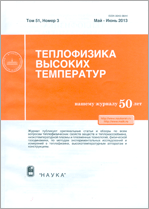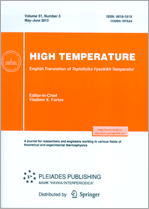|
This article is cited in 1 scientific paper (total in 1 paper)
Heat and Mass Transfer and Physical Gasdynamics
Quenching of liquid carbon on the surface of a diamond substrate
V. S. Dozhdikov, A. Yu. Basharin, P. R. Levashov
Joint Institute for High Temperatures, Russian Academy of Sciences, Moscow
Abstract:
Amorphous carbon is obtained for the first time by quenching liquid carbon. The implementation of the laser melting of graphite flakes pressed onto a diamond substrate makes it possible to implement a scheme for a drop of liquid carbon to fall onto cold diamond. Diamond, due to its uniquely high thermal conductivity, ensures rapid cooling of the resulting melt. The quenching rate is one of the most important parameters affecting the formation and properties of amorphous materials. To calculate the real values of the quenching rate obtained in the experiment, a nonstationary one-dimensional heat conduction equation was solved taking into account the geometric dimensions of the experimental samples. The distribution of liquid carbon quenching rates is determined in the range $10^{14}$–$10^{12}$ K/s depending on the distance from the substrate. The research results showed that diamond can serve as a unique quenching medium for molten liquid carbon with an extremely high temperature of $5000$ to $6000$ K.
Received: 22.03.2021
Revised: 28.05.2021
Accepted: 29.05.2021
Citation:
V. S. Dozhdikov, A. Yu. Basharin, P. R. Levashov, “Quenching of liquid carbon on the surface of a diamond substrate”, TVT, 59:5 (2021), 755–761; High Temperature, 60:1, Suppl. 2 (2022), S248–S254
Linking options:
https://www.mathnet.ru/eng/tvt11551 https://www.mathnet.ru/eng/tvt/v59/i5/p755
|


| Statistics & downloads: |
| Abstract page: | 118 | | Full-text PDF : | 44 | | References: | 23 |
|





 Contact us:
Contact us: Terms of Use
Terms of Use
 Registration to the website
Registration to the website Logotypes
Logotypes








 Citation in format
Citation in format 
